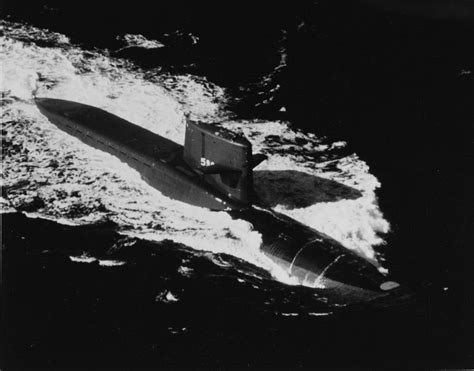The George Washington class submarine was a pioneering force in the United States' naval fleet, marking the country's first foray into nuclear-powered ballistic missile submarines (SSBNs). Named after the first President of the United States, George Washington, this class of submarines played a crucial role in the Cold War era, serving as a deterrent to potential threats and ensuring the nation's security. With the lead boat, USS George Washington (SSBN-598), commissioned in 1959, this class set the stage for the development of future SSBNs, incorporating cutting-edge technology and design principles that would influence submarine construction for decades to come.
Design and Construction

The George Washington class submarines were designed to be multi-mission platforms, capable of launching ballistic missiles, conducting reconnaissance, and engaging in anti-submarine warfare. These vessels were 381 feet (116 meters) in length and had a beam of 33 feet (10 meters), with a submerged displacement of approximately 6,700 tons. Powered by a S5W pressurized water nuclear reactor, they were equipped with two General Electric turbines, producing 15,000 horsepower and enabling the submarines to reach speeds of over 20 knots (37 km/h) when submerged. The class included five submarines: USS George Washington (SSBN-598), USS Patrick Henry (SSBN-599), USS Theodore Roosevelt (SSBN-600), USS Robert E. Lee (SSBN-601), and USS Abraham Lincoln (SSBN-602).
Nuclear Power and Ballistic Missile Capability
A significant advancement in the George Washington class was the integration of nuclear power, which greatly enhanced their endurance and capability to remain at sea for extended periods. Each submarine was armed with 16 UGM-27 Polaris A1 ballistic missiles, which were stored in silos within the submarine’s hull. The Polaris missile system was a major leap forward in terms of range and accuracy, providing the United States with a robust nuclear deterrent. The submarines’ nuclear power plants and ballistic missile systems were designed and constructed with the highest level of secrecy and security, reflecting the critical nature of their mission during the Cold War.
| Submarine | Commissioned | Decommissioned |
|---|---|---|
| USS George Washington (SSBN-598) | December 30, 1959 | January 24, 1985 |
| USS Patrick Henry (SSBN-599) | April 11, 1960 | May 25, 1984 |
| USS Theodore Roosevelt (SSBN-600) | February 13, 1961 | February 28, 1981 |
| USS Robert E. Lee (SSBN-601) | September 15, 1960 | December 1, 1983 |
| USS Abraham Lincoln (SSBN-602) | March 11, 1961 | February 28, 1981 |

Key Points
- The George Washington class was the first class of submarines in the world to be equipped with nuclear ballistic missiles.
- These submarines were powered by a S5W pressurized water nuclear reactor, enabling extended operations without the need for refueling.
- The class played a pivotal role in the Cold War as a strategic deterrent, ensuring the security of the United States and its allies.
- The development and deployment of the George Washington class submarines marked a significant technological and strategic leap forward in naval warfare.
- The submarines' service during the Cold War era underscored the importance of stealth, endurance, and nuclear deterrence in maintaining global stability.
Operational History and Impact

The George Washington class submarines conducted numerous patrols during their service, with their presence helping to maintain the balance of power during the Cold War. The strategic deterrence provided by these submarines played a crucial role in preventing the escalation of conflicts, as their capability to launch nuclear missiles from undisclosed locations at sea presented a formidable challenge to potential adversaries. The operational history of the George Washington class also highlighted the importance of crew training, maintenance, and logistical support in ensuring the effectiveness of naval assets.
Legacy and Retirement
As newer classes of submarines, such as the Benjamin Franklin and Ohio classes, were introduced, the George Washington class submarines began to be retired from service. The lead boat, USS George Washington, was decommissioned on January 24, 1985, after nearly 26 years of service. The retirement of the George Washington class marked the end of an era in submarine development, but their legacy continued to influence the design and operation of subsequent SSBNs. The technological advancements and strategic lessons learned from the George Washington class have contributed to the ongoing development of the United States’ submarine force, ensuring its continued relevance and effectiveness in modern naval warfare.
What was the primary mission of the George Washington class submarines?
+The primary mission of the George Washington class submarines was to serve as a strategic deterrent by carrying nuclear ballistic missiles, thereby ensuring the security of the United States and its allies during the Cold War era.
How did the George Washington class submarines contribute to the development of future submarines?
+The George Washington class submarines set a precedent for the design and operation of future SSBNs, incorporating nuclear power and ballistic missile capability. Their service and technological advancements influenced the development of subsequent submarine classes, contributing to the evolution of the United States' naval strategy and global military presence.
What was the significance of the George Washington class submarines during the Cold War?
+The George Washington class submarines played a pivotal role in the Cold War as a strategic deterrent, helping to prevent the escalation of conflicts through their capability to launch nuclear missiles from undisclosed locations at sea. Their presence maintained the balance of power and underscored the importance of stealth, endurance, and nuclear deterrence in maintaining global stability.
The George Washington class submarines represent a significant chapter in the history of naval warfare, marking the beginning of the nuclear-powered ballistic missile submarine era. Their technological innovations, strategic importance, and operational history have left a lasting impact on the development of submarines and the role of naval forces in maintaining global security. As the world continues to evolve, the lessons learned from the George Washington class will remain relevant, influencing the design, operation, and strategic deployment of future naval assets.

